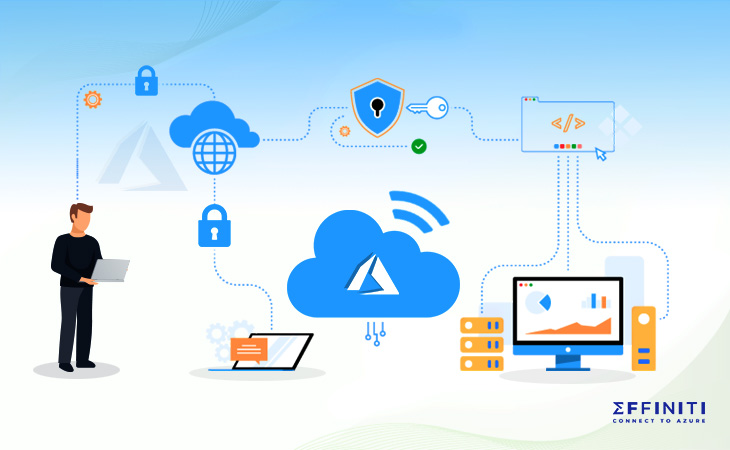Azure is one of the biggest proponents when it comes to application development. The demand from the developers continues to spike as Microsoft continues to make its cloud solution better. With its multi-edge and multi-cloud capabilities, Azure is lending significant control over its infrastructure to developers as they can now run open-source applications on the cloud.
From Linux to Python, one can run various open-source software on the Microsoft cloud. Regardless of their databases, programming languages, and operating systems, one can develop solutions on the IaaS and PaaS infrastructures of Azure.
Appreciating the rising usage of open-source applications, Microsoft has increased its contributions to open-source organizations such as Cloud Native Computing Foundation and Open-source Security Foundation.
As Azure continues to amaze developers with its all-inclusive approach, we, at Effiniti, bring forth the open-source developments that Azure has introduced to the world.
1) Microsoft’s Inclination Towards Open-Source Apps

Open-source applications have produced some of the best solutions in the world. This is primarily to the increased collaboration and multiple contributions which propel the solution to its zenith. Microsoft has ingrained Azure with support for open-source applications, which is an encouraging development.
The developers who have harnessed Azure have benefited from Microsoft’s inclination. The fact that 30,000 employees of the software giant have GitHub accounts goes on to vindicate that Microsoft developers are hard at work with open-source applications.
2) Azure’s Strategic Advantage with Open-Source Apps

Azure is one of the most malleable cloud solutions out there. Although AWS and GCP exist as its competition, Azure has outclassed them with its hybrid and multi-cloud strategies. Continuing its streak, Azure has expanded its capabilities to support open-source solutions development.
Complex architectures are now simplified and secured by Azure’s state-of-the-art Software Development Lifecycle (SDL). The simplification and security are some of the many advantages which the developers of Azure enjoy.
Kubernetes or K8s is one of the most favored open-source software containers as they are easy to be developed and deployed. The same is the case with various microservices and other DevOps solutions that pave the way to the future.
As per Microsoft, 99 percent of the future apps will be built on microservice architectures. This architecture would improve collaboration as it is open and portable for agile development.
Tapping into the demand, Microsoft has constructed the Azure Kubernetes Service, which helps in the container deployment and execution. It also autoscales as per the demand and propels innovation with continuous integration and continuous delivery (CI/CD) pipeline.
The benefits of microservices are better reaped when event-driver architecture is utilized. Comprehending that aspect, Kubernetes Event-Driven Autoscaling (KEDA) was created by Azure as an open-source project. KEDA has strong-armed developers with event-driven architecture and serverless technologies to any software container.
Also Read: An In-Depth Comparison of Azure vs. Google Cloud vs. AWS Services
One can exploit the benefits of KEDA with serverless Azure feature ‘Functions’. The feature, which spans over 10 different open-source projects on GitHub, reduces cost and development time as developers needn’t focus on infrastructure management anymore.
Apart from Functions, Microsoft has doled out another feature called Azure Red Hat OpenShift. The feature complements K8s and accelerates containerization with a better developer and operational experience. The OpenShift feature packs manageable and readily available clusters. Microsoft and Red Hat monitor and manage these clusters and provide them to the developers on-demand.
Also generally available is Microsoft Build of OpenJDK, which brings in Long-Term Support (LTS) and open-source application OpenJDK. Developers can become footloose as the feature gives advanced flexibility and portability.
3) Innovation Unlocked with Azure

It is no secret that Azure incorporates machine learning and artificial intelligence to boost the innovation of its clients. When it comes to open-source applications, Azure has utilized its machine learning feature to complement python platforms.
One can track the development lifecycle of software with the help MLFlow feature, which quells throttling issues that are generally coughed up by PyTorch Profiler. The PyTorch Profiler can be operationalized through ONNX Runtime, which is a high-performance inference and training engine. The ONNX tool is powerful enough to make transformer models 45 percent faster.
Final Thoughts

Microsoft is one of the few companies which understands the wonders that collaboration can generate. Couple the collaborative efforts with open-source applications, one has the potential to create masterpieces.
However, coupling open-source applications with Azure is an effort by itself as the cloud’s features are shrouded by various other offerings. It is cost and time-effective for the organizations to employ the services of Effiniti.
Having an affinity for innovation, Effiniti has doled out solutions that propelled leading figures of Fortune 500. Collaborate with us and embrace the unlimited potential of open-source applications features on Azure.
More Articles:
- Azure Economics Simplified: Harnessing Cloud Advantages Cost-Effectively
- The Benefits that Clients Enjoy When They Lift and Shift on Azure
- Propel Your Innovation with Azure’s Multi-Cloud and Multi-Edge Hybrid Capabilities
- Why is Azure the preferred choice of SAP Clients? Answered!
- How are Businesses Harnessing Azure DevOps for Optimal Performance?
- Why are Businesses Racing to Azure DevOps? Here are The Top Compelling Reasons!
- Why SME and Fortune 500 companies choose Azure Cloud Services?

